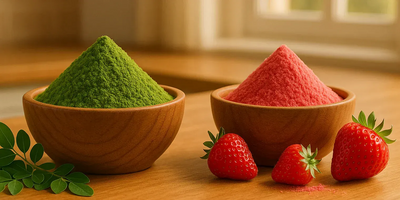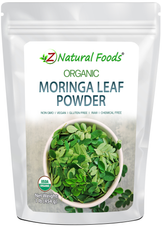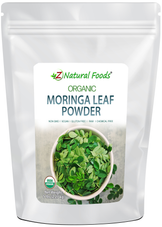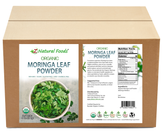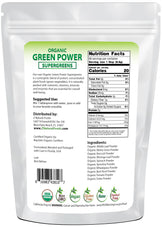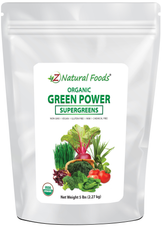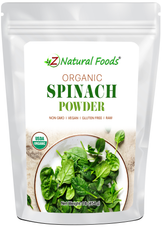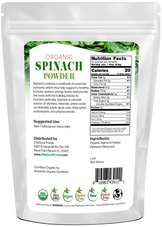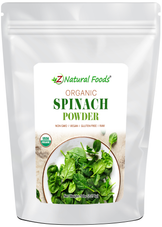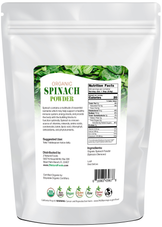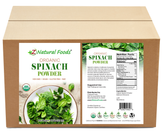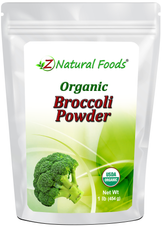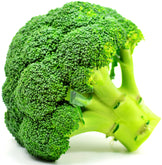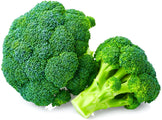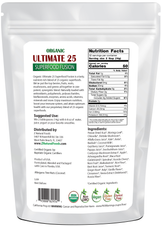Description
Description
Green foods have a tremendous reputation for providing high-quality nourishment, like micronutrients and polyphenols, specifically chlorophyll (The pigment that gives green foods their color).
When prepared and utilized correctly, they can be a great and easy way to bring supportive nourishment to your daily program. There is overwhelming evidence that green foods are incredibly nutritious and provide our detoxification pathways tremendous support with critical nutrients and compounds needed for optimal function.
Moringa, also known as the tree of life, is often hailed as nature's ultimate multivitamin/mineral. Its exceptional content of around 92 nutrients and 46 antioxidants sets it apart, offering nutritional qualities that surpass other green foods.
Today, we delve into the unique nutritional profile of moringa leaf powder and its benefits. Moringa leaf is a powerhouse of nourishment, including chlorophyll, the vitamin K family, and a full spectrum of carotenoids.
- Chlorophyll, the compound responsible for plants' deep green color, plays a pivotal role in the body's absorption of nutrients. Its two primary types, A and B, are fat-soluble compounds with highly nourishing and protective properties. When ingested, chlorophyll aids in absorbing lipids and fat-soluble nutrients, highlighting its crucial role in our health.
- Vitamin K, a family of fat-soluble vitamins, is crucial for many essential biological processes such as blood clotting, bone building, and potentially reducing calcium deposits in the arteries. This family includes three forms of vitamin K. Vitamin K1 (phylloquinone) is primarily found in green leafy vegetables, while Vitamin K2 (Menaquinone) is abundant in fermented foods, milk, meat, eggs, and cheese. Vitamin K2 has multiple subtypes, including MK-4, MK-6, MK-7, and MK-9, with MK-4 primarily found in animal fats like egg yolks, lard, and butter, and MK-7 mainly found in Natto, a fermented soybean product. However, please remember that while moringa is a good source of K1, it does not contain K2 (animal foods) and K7 (fermented foods).
- Carotenoids are a class of red, orange, or yellow fat-soluble pigments produced by plants, algae, and photosynthetic bacteria. There are more than 600 types, including alpha and beta carotene, lycopene, lutein, and beta-cryptoxanthin, each with unique attributes. They are researched for their potential to provide antioxidant-like qualities, informing us about their potential health effects.
- Carotenoids are classified into two primary groups: xanthophylls (which primarily protect from too much sunlight, contain oxygen, have more yellow pigment, and are associated with nourishing the eyes), which are closely associated with green leafy vegetables, and Carotenes(which have no oxygen and are associated with orange pigment).
However, moringa leaf powder offers so much more.
Moringa is renowned for its rich amino acid content, containing all nine essential amino acids among its 15 amino acids. While some experts suggest moringa as a potential substitute for meat, fish, and eggs due to its complete protein profile, it's important to note that the balance of these amino acids may be more critical for overall protein utilization. However, moringa remains an excellent source of all 15 amino acids, known to support various aspects of health.
When we think of polyphenols, we often think of food with bright, vibrant colors like red, blue, purple, yellow, and orange. However, green foods are frequently the most underrated category of high polyphenolic foods. Moringa is a superstar of several of the most potent compounds researched in this food science category.
Polyphenols are a term used to describe a general category of compounds found in a broad spectrum of fruits, vegetables, and tea that work as “reducing agents” along with other compounds known as antioxidants to support a healthy inflammation response and the body's ability to protect and repair damaged tissue caused by oxidative stress. While over 8,000 polyphenols have been identified, some of the most common are flavonoids, flavonols, and anthocyanins. The importance of discussing these various compounds allows you to more clearly understand the wide range and complexity of nourishment you are getting from these powerful foods. They represent the pigments that exhibit the bright red, purple, and blue colors found in fruits and vegetables. The six most common are Cyanidins, Delphinidins, Malvidins, Peonidins, Petunidins, and Pelargonidins.
The power of Flavinoids
Many health experts believe that a diet rich in flavonoids, a category of compounds found in a wide range of fruits, vegetables, and tea, is crucial for supporting a healthy aging process. Flavonoids are known as nature’s biological response modifiers. There are over 8,000 different types of flavonoids found in nature, and the total daily amount you consume matters, whether from food or supplements. Experts recommend a daily intake of 500 to 2000 milligrams of flavonoids from various sources.
A randomized controlled trial discussing how flavonoid-rich foods improve microvascular reactivity and inflammatory status in men at risk for cardiovascular disease showed the following.
- The HF F&V diet increased endothelium-dependent microvascular reactivity
- Reduced C-reactive protein and vascular cell adhesion molecule
- HF F&Vs increased plasma NO in the group as a whole.
Therefore, the following was concluded, “These data support recommendations to increase F&V intake to ≥ 6 portions daily, with additional benefit from F&Vs that are rich in flavonoids, particularly in men with an increased risk of CVD.”
Quercetin
Of the various flavinoids, Quercetin was found to be the most abundant, with approximately 40% of the total flavinoid content in moringa leaf. Moringa was found to have around 77 times the amount of quercetin (1363 mg/ per kg) compared to spinach (17.9 mg/ per kg). Other assays comparing moringa to onions(believed to be an absolute superstar of quercetin), looking at 100-gram servings, state that moringa contains 100 mg of Quercetin and onions between 29-49 mg. Quercetin is being aggressively studied for its ability to support a healthy aging process through various mechanisms of action.
In an overview of the biological importance of quercetin, it was stated that “Quercetin, a plant pigment, is a potent antioxidant flavonoid and more specifically a flavonol, found mostly in onions, grapes, berries, cherries, broccoli, and citrus fruits. It is a versatile antioxidant known to possess protective abilities against tissue injury induced by various drug toxicities.” However, there appears to be a new quercetin king in town, Moringa.
Kaempferol
Finally, kaempferol, a potent flavonol found in moringa, has a robust growing body of evidence supporting its unique effects. According to a National Library of Medicine review, “kaempferol has been reported to modulate several key elements in cellular signal transduction pathways linked to apoptosis, angiogenesis, inflammation, and metastasis while appearing to preserve normal cell viability, in some cases exerting a protective effect.” Ultimately, this compound helps support the regulation of various signaling pathways inside cells. For example, apoptosis is a form of programmed cell death where cells destroy themselves, maintaining the healthy function of the body as compared to neurosis, which is when cells die in an untimely way due to uncontrolled external factors. Spinach is traditionally considered a tremendous source of this nourishing flavonol, providing 215 mg/kg. However, moringa provides around 1935 mg/kg.
Moringa: A Potential Chelating Agent
Preliminary studies have shown that moringa may have protective qualities against heavy metals due to the presence of a phenolic compound called gallic acid. Gallic acid is a potent biologically active phenolic acid compound with antioxidant capabilities. While most well known for being abundant in your cup of java (gallic acid is formed during the roasting process), moringa is also a quality source of this nourishing compound. According to the National Institutes of Health, Gallic acid is the most abundant in dried leaves, with a concentration of 1.034 mg/g dry weight. The concentration of chlorogenic and caffeic acids ranges from 0.018 to 0.489 mg/g of dry weight and 0.409 mg/g of dry weight, respectively.
The following was stated in a study discussing the effects of Moringa leaf extracts and its bioactive compound gallic acid on reducing the toxicities of heavy metals and metalloids in Saccharomyces cerevisiae. AMOLE & EMOLE refer to water vs alcohol extracts of moringa leaf.
- AMOLE remarkably promoted the growth of yeast cells grown in the presence of arsenite (As(III)), Cd, nickel (Ni), and lead (Pb).
- Although the AMOLE contained a lower amount of total phenolic and flavonoid contents and displayed lower DPPH scavenging capacity than the EMOLE, both AMOLE and EMOLE had the same capacity for reducing intracellular ROS levels in yeast cells exposed to As(III), Cd, Ni, and Pb.
- Moreover, AMOLE was more effective than EMOLE in inhibiting the intracellular accumulation of these toxic metals (loid).
- In addition, we found that gallic acid, one of the critical phenolic constituents present in both extracts, could protect yeast cells against As(III) toxicity, likely through its role in decreasing As(III) accumulation and As(III)-induced ROS production.
- Furthermore, gallic acid's hydroxyl and carboxyl groups appear to play a critical role in chelating As(III).
Therefore, the following was concluded, “The present study suggests promising applications of AMOLE (and gallic acid) as protective agents against hazardous metal(loid)s.”
It is important to note that human studies need to be done to verify these claims.
If we haven’t given you enough reasons why moringa is superior to the rest, here is one more.
Because of moringa’s potent nutrient density, it has been studied and used worldwide to help conquer starvation and malnutrition. As mentioned earlier, moringa is a superstar food containing 92 nutrients and 46 antioxidants. In a paper about the potential of using moringa to reduce levels of malnutrition, it was concluded that when the nutrient content found in moringa was added to the subject's daily consumption, their nutrient profiles improved, thereby supporting the reversal of malnutrition. Because moringa trees grow very aggressively in the right conditions, moringa leaves are an ideal sustainable food for this very purpose.
In conclusion, moringa leaf powder may be the needle in the haystack that may change overall health and well-being trajectory.
Moringa is a simple and sustainable food that provides an outstanding nutrient profile in ways that no individual food has been proven to do in quite the same way. So, the next time you are looking for that boost in nourishment, give moringa leaf a try.
To review all of our green foods, go here:
